It’s Time for Realistic Engineer Training
Posted on July 22,2019Article Date Mar 01, 1983
by Maj Charles O. Skipper
Virtually every issue of the Marine Corps GAZETTE published over the past two years has had at least one letter, commentary, or article dealing with maneuver warfare. Marines at The Basic School, Amphibious Warfare School, and Marine Corps Command and Staff College have heard numerous speakers on the subject. The purpose of this article is to delve a little deeper into specific aspects of maneuver warfare-deeper than many would-be practitioners of the art are wont to go.
Inherent in maneuver warfare is the ability of the tactical commander to move his forces. To exercise maneuver warfare successfully, he must be able to move sufficient forces by various means, over varying types of terrain, at the time and place of his choosing (mobility). Simultaneously, he must be able to prevent or restrict the movement of enemy forces (countermobility). Once his forces are committed, the tactical commander must ensure they have sufficient food, water, fuel, ammunition, and protection to achieve their objective (survivability).
If one accepts the above requirements as basic for the orderly achievement of maneuver warfare, then it would appear that combat engineers have a crucial role not only in maneuver warfare, but in every style of ground warfare. After all, if the tactical commander wants freedom of movement for his ground forces, it will be the engineers called in to breach the predictable threat obstacles, such as ditches and minefields, and to install bridges or rafts to get his mechanized forces across both dry and wet gaps. If the tactical commander wants to restrict the ground mobility of the enemy forces, again it will be the engineers who are called in to install log or wire obstacles, dig ditches, emplace minefields, crater roads, or demolish bridges. If he wants to sustain his forces once committed, then the engineers must provide the potable water and bulk fuel; maintain the main supply route (MSR) for effective, timely transport of essential supplies; and dig the fighting and defilade positions that will protect the fighting vehicles, command posts, and artillery positions that are so essential to the success of the operation.
An argument could be made at this point that Marine aviation can be used to enhance mobility by moving troops and equipment by helicopter. A case could also be made for air assets being used to counter the mobility of the enemy. While air assets are of utmost importance, we must recognize two important facts. First, our helicopter assets are just not extensive enough to provide the primary means of mobility for Marine ground forces. Second, we will not always have the air superiority or good weather required to depend totally upon Marine aviation.
Therefore, it is apparent that engineers are crucial to the success of maneuver warfare. There are some critical engineer equipment deficiencies that need to be resolved,* but equally important are the following questions:
– Are developing tactical ground commanders fully aware of the engineers‘ existing capabilities to provide the mobility, countermobility, and survivability required for success on the modern battlefield?
– How effectively are we utilizing the engineer equipment presently in the inventory?
In order to answer these questions let us discuss item by item a few of the key engineer capabilities now available:
Bridging
The Marine Corps presently has in the inventory two types of bridges capable of supporting vehicular traffic, the M4T6 floating bridge, figure 1, and the M6 fixed bridge. Both of these bridges are extremely heavy, antiquated, and slow to erect. They are being replaced (1982-1987) by the medium girder bridge (MGB), figure 2, including a floating version. The MGB is the state of the art for tactical bridging and will certainly enhance the bridging capabilities of the Marine Corps. However, this improvement will do nothing unless Marines get practice in its employment. Seldom, if ever, do Marine tanks, refuelers, and other vehicles drive across bridges made of M6 or M4T6 during field exercises. Few readers will recall a significant Marine Corps tactical exercise that incorporated the timely installation of a key bridge as an integral part of the maneuver plan.
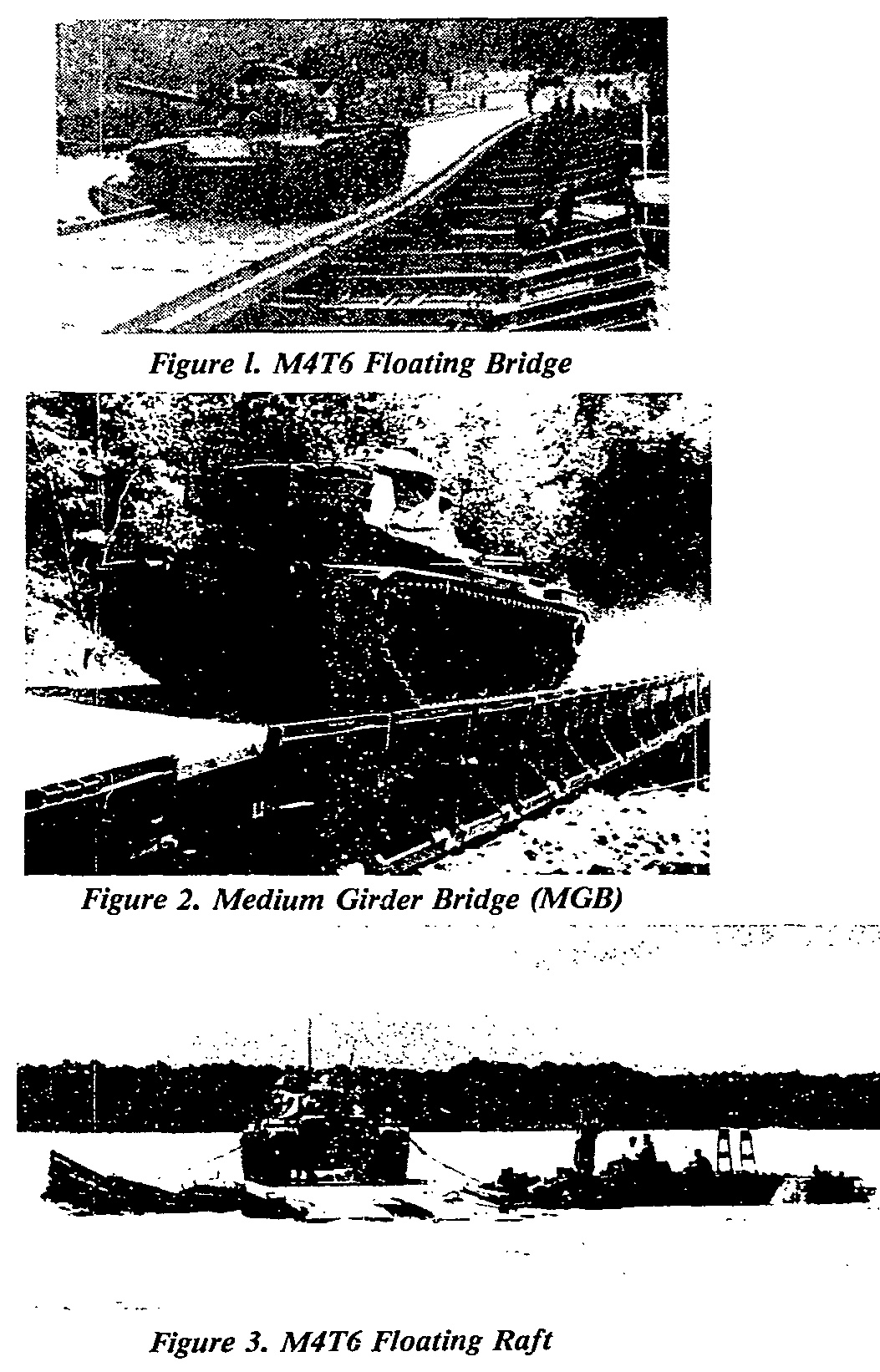
The M4T6 can also be configured as a floating raft, figure 3, for crossing tanks and other nonamphibious vehicles needed to support an initial beachhead for a river crossing. Although each raft would normally require 10-12 hours to construct, rafts could be preassembled in a rear area ahead of time and then flown by helicopter to the crossing site. In this manner a raft could probably be assembled with only three hours work actually on the river site. This would enable us to deceive the enemy longer about our exact crossing site, avoid the large signature of heavy trucks and personnel, and still let us get the tanks and other essential heavy equipment across early enough to help counter the initial enemy reaction. A rafting schedule such as shown in figure 4 demonstrates that an entire tank company could cross a 100-meter-wide river in 59 minutes, once the rafts were constructed. The advantages of having the capability to put a company of tanks across a river to complement the maneuver of lightly armored and lightly armed LAVs and LVTs are obvious.
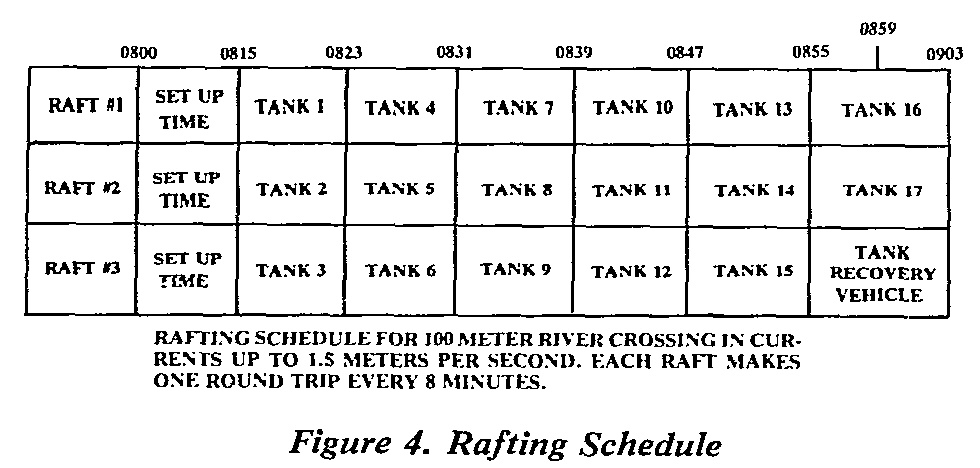
The Marine Corps cannot afford to ignore the problem of tactical river crossings. Geography and military history agree on their importance:
In Norway (where the Marine Corps has pre-positioned equipment and an assigned mission) there is a bridge every 2.2 miles the length of the country.
For every 10 kilometers in Europe there is a river 10-20 meters wide; every 50 kilometers there is one 20-100 meters wide; and every 200 kilometers there is one 100 meters wide.
The 1973 Arab-Israeli War featured crossings of the Suez Canal by both Egyptians and the Israelis.
The conclusions are obvious, we simply must be able to project our combat power across wet or dry gap obstacles with a minimum sacrifice of momentum. We must appreciate the fact that river-crossing operations are exceeded in complexity only by amphibious operations. In fact, the U.S. Army has published an entire manual on the subject, FM 90-13, River-Crossing Operations. We must emphasize gap crossing in our exercises and ensure our units can accomplish it.
Breaching Minefields
Present doctrine calls for expedient breaching of minefields by using the M58A1 line charge. By 1984 it will be possible to fire the line charge from a kit installed in an LVTP7, figure 5, or mounted on an M353 trailer towed behind a variety of vehicles (preferably armored), figure 6. Until then the line charge must be set up and fired from the ground (not a very fast method) or fired from the bed of a dump truck (no armored protection for the driver or engineers attempting the breach). Although this line charge has been in the inventory for 25 years, how many exercises does the reader recall where utilizing it to breach a minefield was essential for accomplishment of a key maneuver. There is now an event in the Combined Arms Exercises (CAXs) at Twentynine Palms that includes utilizing the prototype trailer-mounted line charge to breach a minefield, but that is just not enough. The Soviets’ capability to install minefields is massive; and everytime we have an exercise with Marines moving across ground against opposition, they should practice breaching minefields. Getting through a Soviet minefield will require several breach points and more than a single line charge per breach since Soviet minefields will probably not be a uniform 100 meters in depth (the effective length of the line charge). Speed will be absolutely critical since the Soviets will cover their minefields with fire. If we think we can do it right the first time under combat conditions, we are fooling ourselves. An exercise that omits training in this key area is unrealistic.
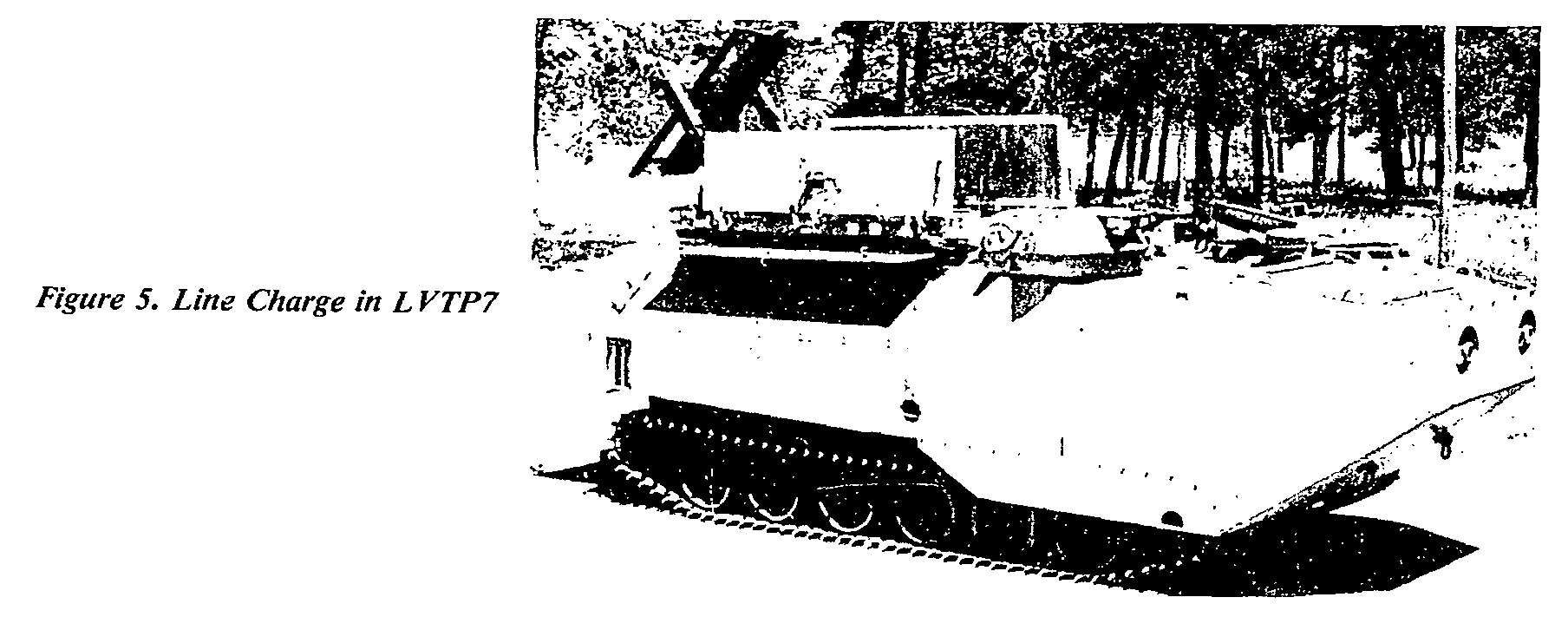
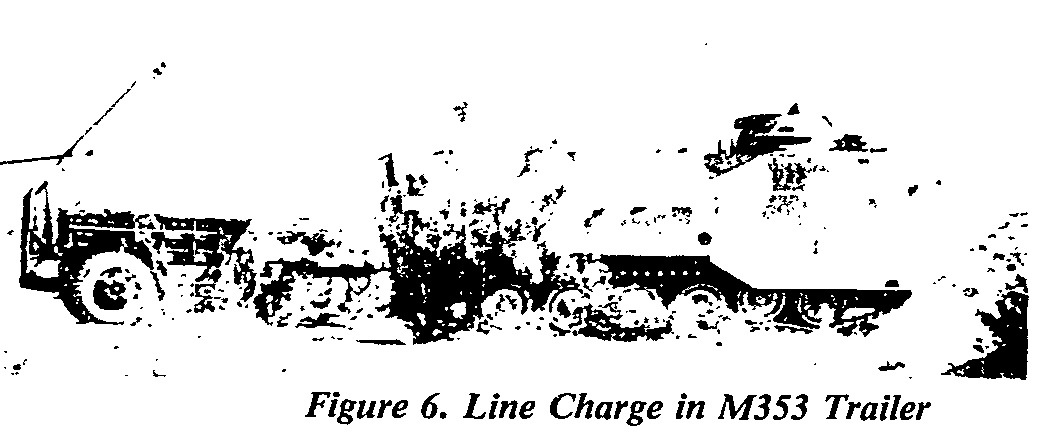
Breaching Tank Ditches and Craters
Present doctrine calls for tank ditches and craters to be breached using dozer tanks. There are only four such tanks per division, and that number is inadequate. If a Marine force was required to breach an antitank ditch, in all probability thin-skinned bulldozers or dump trucks would of necessity be employed. Once again few readers will recall an exercise that required tanks or LVTs to get across a tank ditch in order to move to their objective. The CAXs at Twentynine Palms sometimes require a single breach of a tank ditch. This is a small step in the right direction but only reflects the severity of the problem. Twenty to 30 minutes is the normal time required for these breaches at Twentynine Palms, and that is unacceptable. The 1973 Arab-Israeli War showed that 3-5 minutes was the maximum time that should be allowed to effect a breach of a tank ditch. Anything longer usually enabled the defending force to destroy the stalled assaulting force. Until the Marine Corps decides to develop or purchase an armored engineer vehicle, the job will have to be done by thin-skinned bulldozers and dumptrucks. The important consideration is that effective procedures must be developed and practiced. With proper orchestration of Marine air and artillery providing suppressive fire and smoke, perhaps the thin-skinned engineers can make the required breaches. The timing will be crucial, however, and this means practice.
Water
Presently in the USMC inventory are 600-and 1,500-gallon-per-hour (GPH) water purification units. These units are being replaced in (1982-1988) by the 600-GPH reverse osmosis water purification unit, figure 7. No one doubts the necessity of potable water for Marines; in fact, it is an item stressed to all Marines in leadership positions. The problem is where the water comes from. It is much easier to use commercial water sources during exercises. Commercial water is usually readily available from a variety of sources, tastes good, and there is little distribution problem. Seldom do water supply men, MOS 1121, purify all the water used to support the maneuver force. Again, these Marines need practice. To purify water requires setting up, operating, and maintaining numerous items of equipment. Chemicals and filters must be used to make the water safe and drinkable. It is one thing for the Gunny to teach his troops how to set up a water point, make a few hundred gallons of water, and tear down the water point all in one day. It is quite another for the team effort to set up the number of required water points, have the necessary types and amount of chemicals on hand, and run the water points round the clock to make the 1 million gallons per day required to support a MAF by D+15. Additionally, there will be a heavy commitment of drivers and vehicles to transport the water. At present many of these drivers are always available for other missions, and this generates a false sense of security. Water is essential, so we need to practice making it and transporting it on our tactical exercises. This is especially important with the current emphasis on the arid Middle East and the potential of NBC contamination of water supplies.
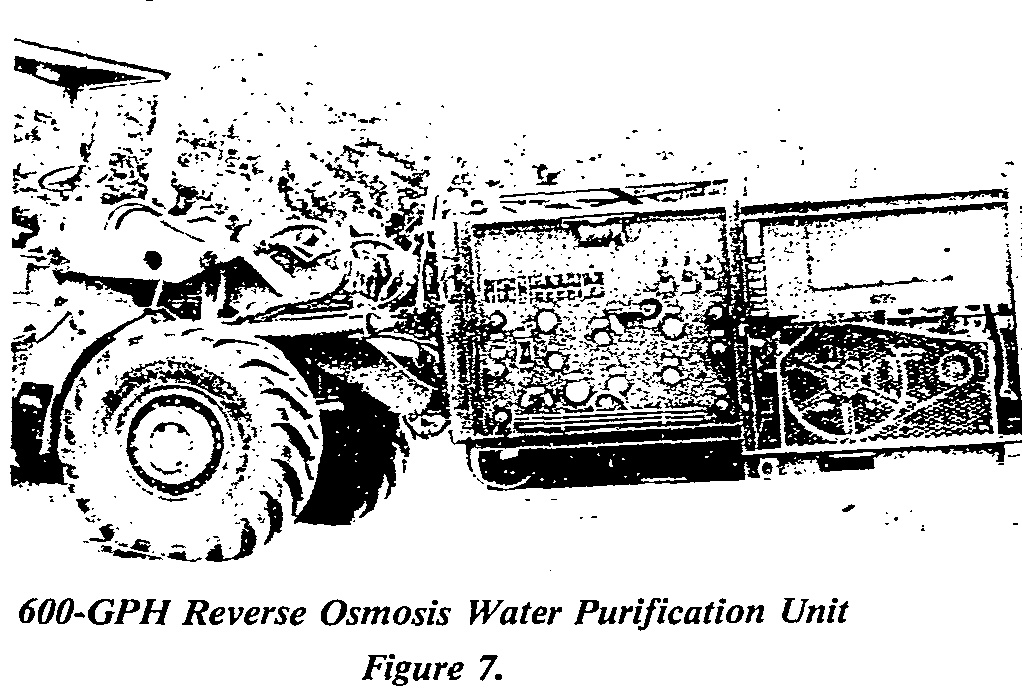
Fuel
The basic Marine concept for bulk fuel is that fuel will be pumped ashore from amphibious ships using the amphibious assault fuel system (AAFS), figure 8. From there it will be distributed to the wing or ground units as required. The ground units will receive their fuel from fuel farms via tanker truck, and aircraft will be refueled via helicopter expedient refueling systems (HERS) or tactical airfield fuel dispensing systems (TAFDS). This is a fine concept, but it is very seldom completely exercised. Seldom, if ever, is the AAFS utilized to pump fuel ashore, probably because of the logistic and environmental problems. Also, seldom is a full TAFDS set up. Most Marine aviation exercises center around an existing airfield with a permanent aircraft fueling system. The problems with the above approach are similar to the others. Berms must be dug to hold the storage bladders, and a complex assortment of fuel bladders, pumps, filters, monitors, etc., must be set up and operated. Present plans estimate a requirement of 1 million gallons of fuel a day by D+15 in a MAF-level amphibious operation. To expect this lifeblood of support to flow smoothly without periodically practicing it is just not realistic. We all remember the scene from the movie Patton where his tanks run out of fuel. Well, that might have been acceptable then, but do we want to chance that now?
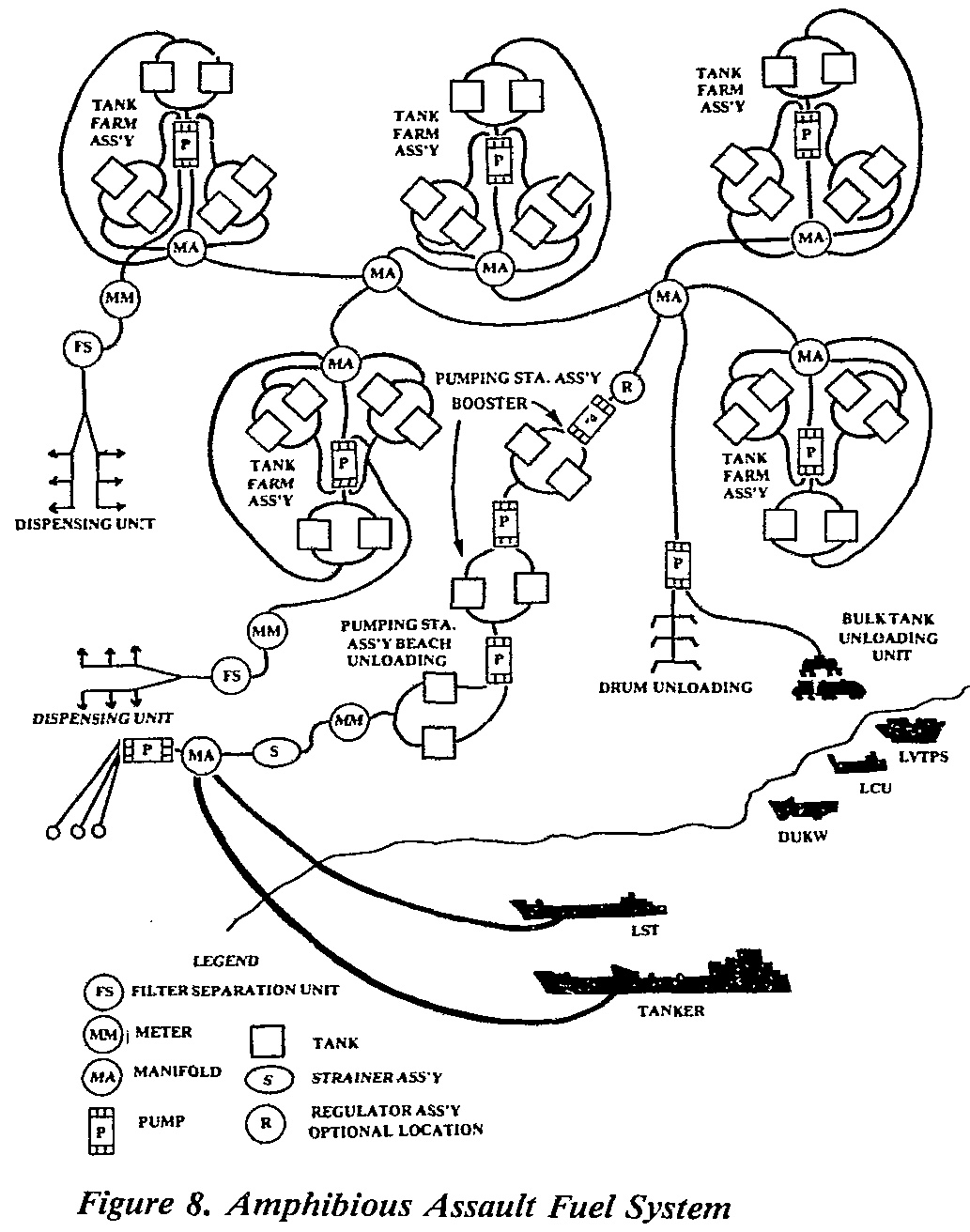
Defilade Positions
Studies have shown the vastly increased survivability of vehicles, artillery, and CPs when they are dug into defilade positions, figure 9. Engineers have an extensive amount of earth-moving equipment that can provide this neces sary support, but it must be organized into effective units and combinations of equipment to provide the optimum capability. These task organized “emplacement units” must then practice digging defilade positions just like the artillery practices displacement. They must stay with the units they support and practice the position preparations in order to get the time required as short as possible. It should be emphasized that this is not a pure defensive action, as units should dig in even when they halt on the offense. In the hurry scurry of combat who will decide the priorities of who gets the limited engineer support? Such priority issues should be dealt with now, in training, when time is available to make sound decisions.
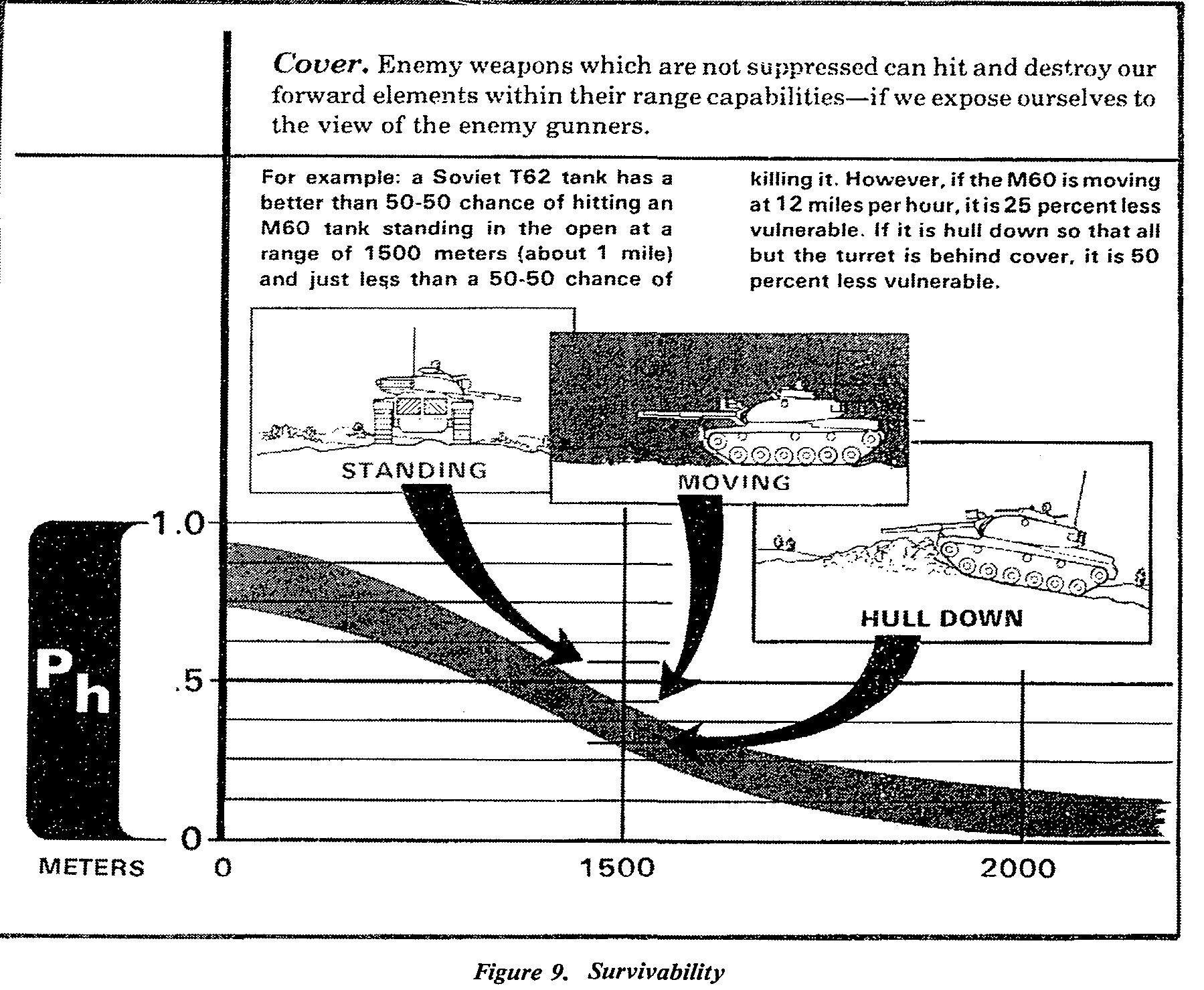
Installing Obstacles
Engineers can install minefields, dig ditches, demolish bridges and buildings, and utilize trees and wire to create obstacles, figure 10. Primarily an offensive force like Marines would utilize this capability for flank security, but it also could be useful during retrograde operations. The important consideration is that engineers need to be active participants in the overall strategy of the maneuver commander. If not, the force could be overly vulnerable to attacks from the flank. Failure of the Germans to blow the Remagen bridge over the Rhine River hastened their defeat in World War II. Failure of the Egyptians to protect their flanks in 1973 led to the encirclement of their Third Army and ultimately the end of their offensive. The examples from military history abound, and the lesson they clearly teach is that we should practice this capability in our training exercises.
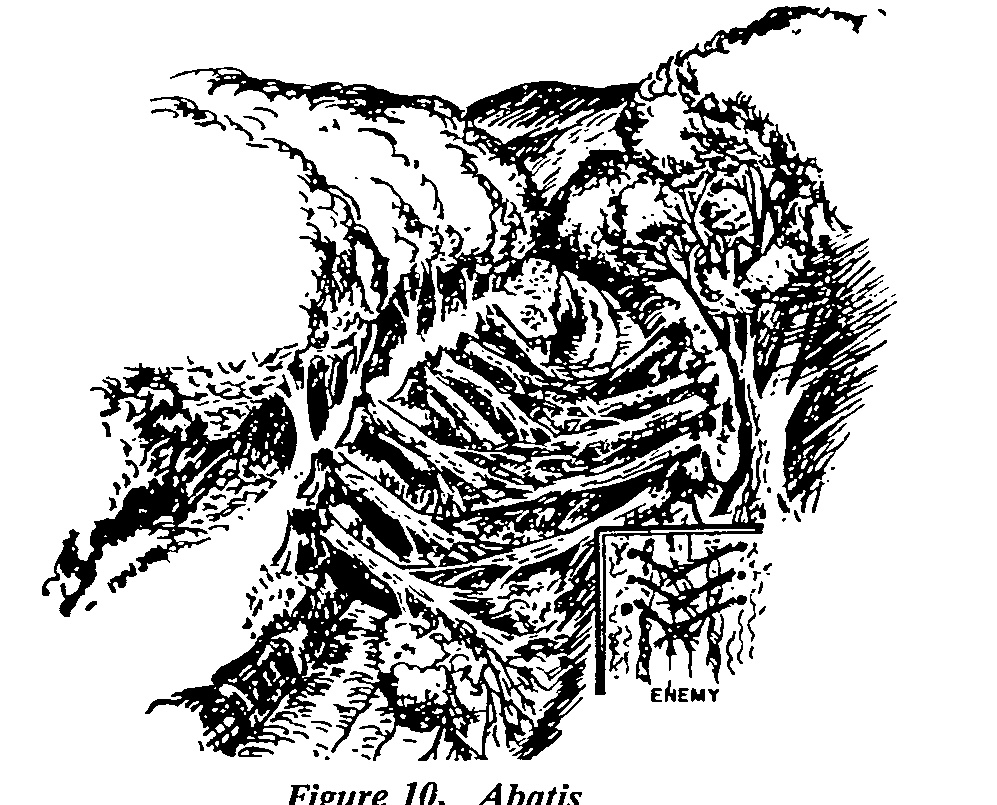
Expeditionary Airfields
Expeditionary airfields can be established ashore during the early phases of an amphibious operation. Early establishment of these airfields will sever the Marine aviation umbilical cord to naval shipping, providing more responsive and more timely air cover as Marines continue the advance inland. Utilizing existing stocks of AM-2 aluminum matting and a building block concept, airfields ranging in size from a 72×72 foot vertical takeoff and landing (VTOL) forward operating site to an 8,000-foot strategic expeditionary landing field (SELF) can be constructed. It is important to note that again these airfields are seldom constructed. Although it is not realistic to assume we will be able to capture enemy airfields undamaged, almost all Marine aviation training exercises center around existing permanent airfields. By practicing the construction of expeditionary airfields, we would establish the most efficient combination of men and equipment required for implementation. We would better understand the logistical requirements in terms of equipment, personnel, POL, etc.; we would know how many days or weeks are required for construction; and, finally and most importantly, we would enhance our capabilities to phase Marine aviation ashore.
SUMMARY
This brief article has attempted to make a case for the more extensive use of combat engineers in support of all ground warfare operations-not just in wartime, but right now on all training exercises. Just as a football team in the Super Bowl would not run a play without practicing it, the Marine Corps should not expect to get successful combat engineer support in future maneuver warfare without practicing the support ahead of time as a team. Realistically, several actions must take place in order for the Marine Corps to correct the inadequate level of engineer involvement in combined arms training:
– The MCCRES must be modified; not just to test the engineers more extensively, but to test the ability of maneuver units to employ engineers. If we are to fight as a combined arms team, we ought to be evaluated as such.
– Training exercises must be expanded to allow more realistic engineer play. Any exercise that allows Marines to move over ground toward simulated enemy forces without encountering minefields, tank ditches, rivers, and other obstacles is simply poor, unrealistic training.
– Battalion, regiment, and division engineers must work for the G/S-3, not the G/S-4. The very nature of engineer support is tactical, not logistical. The engineer is the one most qualified to advise the G/S-3 of the full implications of terrain on both offensive and defensive operations.
– The realities of environmental concerns must be put in proper perspective. You cannot practice digging a defilade position or tank ditch without digging it. It simply cannot be done on paper.
I hope that all the existing maneuver unit commanders who may read this article can sit back and relax because they have practiced the operations previously discussed and because they have great confidence in the engineer officer whose platoon, company, or battalion will support them in combat. If not, the solution is available. All that is required is a commitment to start practicing today for the realities that will certainly be present in our next battle. Our training exercises may be longer and more complicated, but the benefits to our fighting capabilities will far outweigh the disadvantages. Let’s call the combat engineers in off the bench; it is time for them to move up to “first string” on the Corps’ combined arms team.
* A detailed discussion of current deficiencies in engineer equipment is beyond the scope of this article. Years of underfunding, a low priority compared with ordnance equipment, and an overdependence on the U.S. Army to develop modern equipment capable of providing close combat engineer support to Marines have all caused the problem. The solution will only be realized when a consensus is reached that, although modern combat engineer equipment may lack glamour, it is nevertheless absolutely essential to successful combat operations ashore.




